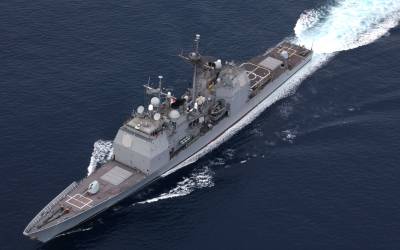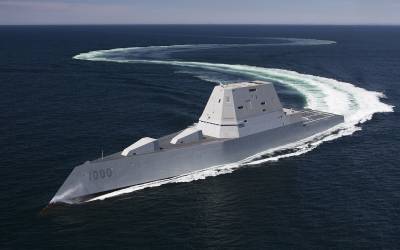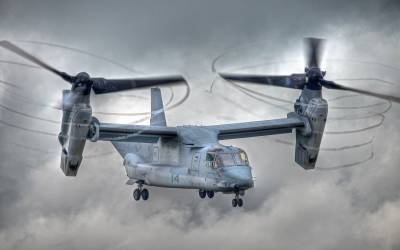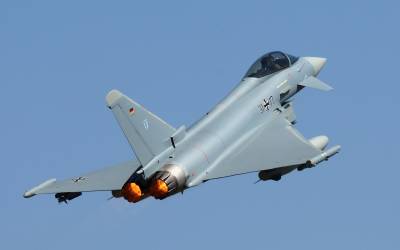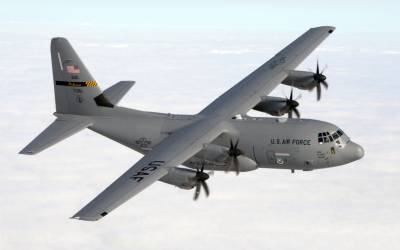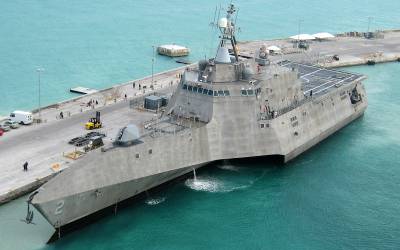April 25, 2024
Serious Dollars for AEGIS Ballistic Missile Defense (BMD)
AEGIS-BMD: CG-70 launches SM-3 (click to view full) The AEGIS Ballistic Missile Defense System seamlessly integrates the SPY-1 radar, the MK 41 Vertical Launching System for missiles, the SM-3 Standard missile, and the ship’s command and control system, in order to give ships the ability to defend against enemy ballistic missiles. Like its less-capable AEGIS […]
Full Article Status: paid
April 24, 2024
The USA's DDG-1000 Zumwalt Class Program: Dead Aim, Or Dead End?
67% of the fleet (click to view full) DID’s FOCUS Article for the DDG-1000 Zumwalt Class “destroyer” program covers the new ships’ capabilities and technologies, key controversies, associated contracts and costs, and related background resources. The ship’s prime missions are to provide naval gunfire support, and next-generation air defense, in near-shore areas where other large […]
Full Article Status: paid
April 22, 2024
V-22 Osprey: The Multi-Year Buys, 2008-2021
(click to view full) In March 2008, the Bell Boeing Joint Project Office in Amarillo, TX received a $10.4 billion modification that converted the previous N00019-07-C-0001 advance acquisition contract to a fixed-price-incentive-fee, multi-year contract. The new contract rose to $10.92 billion, and was used to buy 143 MV-22 (for USMC) and 31 CV-22 (Air Force […]
Full Article Status: paid
April 11, 2024
F-35 Lightning: The Joint Strike Fighter Program
F-35B: off probation (click to view full) The $382 billion F-35 Joint Strike fighter program may well be the largest single global defense program in history. This major multinational program is intended to produce an “affordably stealthy” multi-role fighter that will have 3 variants: the F-35A conventional version for the US Air Force et. al.; […]
Full Article Status: free
April 11, 2024
KC-46A Pegasus Aerial Tanker Completes Firsts
KC-135: Old as the hills… (click to view full) DID’s FOCUS articles cover major weapons acquisition programs – and no program is more important to the USAF than its aerial tanker fleet renewal. In January 2007, the big question was whether there would be a competition for the USA’s KC-X proposal, covering 175 production aircraft […]
Full Article Status: paid
April 8, 2024
Eurofighter's Future: Tranche 3, and Beyond
Italian Eurofighters (click to view full) The multi-national Eurofighter Typhoon has been described as the aerodynamic apotheosis of lessons learned from the twin engine “teen series” fighters that began with the F-14 and F-15, continued with the emergence of the F/A-18 Hornet, and extended through to the most recent F/A-18 Super Hornet variants. Aerodynamically, it’s […]
Full Article Status: paid
April 1, 2024
MQ-9 Reaper: Unfettered for Export
0 Reaper, ready… (click to view full) The MQ-9 Reaper UAV, once called “Predator B,” is somewhat similar to the famous Predator. Until you look at the tail. Or its size. Or its weapons. It’s called “Reaper” for a reason: while it packs the same surveillance gear, it’s much more of a hunter-killer design. Some […]
Full Article Status: paid
April 1, 2024
ER/MP Gray Eagle: Enhanced MQ-1C Predators for the Army
ER/MP, armed (click to view full) Its initial battles were fought within the Pentagon, but the US Army’s high-end UAV has made its transition to the battlefield. The ER/MP program was part of the US Army’s reinvestment of dollars from the canceled RAH-66 Comanche helicopter program, and directly supports the Army’s Aviation Modernization Plan. The […]
Full Article Status: paid
March 20, 2024
The C-130J: New Hercules & Old Bottlenecks
RAAF C-130J-30, flares (click to view full) The C-130 Hercules remains one of the longest-running aerospace manufacturing programs of all time. Since 1956, over 40 models and variants have served as the tactical airlift backbone for over 50 nations. The C-130J looks similar, but the number of changes almost makes it a new aircraft. Those […]
Full Article Status: paid
March 14, 2024
The MQ-4C Triton: Poseidon's Unmanned Herald
BAMS Operation Concept (click to view full) The world’s P-3 Orion fleets have served for a long time, and many are reaching the end of their lifespans. In the USA, and possibly beyond, the new P-8 Poseidon Multi-mission Maritime Aircraft will take up the P-3’s role. While the P-8’s base 737-based airframe offers strong service […]
Full Article Status: paid
March 13, 2024
The JAS-39 Gripen: Sweden's 4+ Generation Wild Card
South African JAS-39D (click to view full) As a neutral country with a long history of providing for its own defense against all comers, Sweden also has a long tradition of building excellent high-performance fighters with a distinctive look. From the long-serving Saab-35 Draken (“Dragon,” 1955-2005) to the Mach 2, canard-winged Saab-37 Viggen (“Thunderbolt,” 1971-2005), […]
Full Article Status: paid
March 4, 2024
LCS: The USA's Littoral Combat Ships
Austal Team Trimaran LCS Design (click to enlarge) Exploit simplicity, numbers, the pace of technology development in electronics and robotics, and fast reconfiguration. That was the US Navy’s idea for the low-end backbone of its future surface combatant fleet. Inspired by successful experiments like Denmark’s Standard Flex ships, the US Navy’s $35+ billion “Littoral Combat […]
Full Article Status: sample
February 29, 2024
AMRAAM: Deploying & Developing America's Medium-Range Air-Air Missile
AIM-120C from F-22A (click for test missile zoom) Raytheon’s AIM-120 Advanced, Medium-Range Air to Air Missile (AMRAAM) has become the world market leader for medium range air-to-air missiles, and is also beginning to make inroads within land-based defense systems. It was designed with the lessons of Vietnam in mind, and of local air combat exercises […]
Full Article Status: paid
February 21, 2024
Super Tucano Counter-Insurgency Plane Makes Inroads in Africa
Super Tucano Embraer’s EMB-314 Super Tucano trainer and light attack turboprop continues to rack up global orders, solidifying its position as the globe’s pre-eminent manned counter-insurgency aircraft. The latest order set of about $180 million expands the plane’s footprint into 3 African states: Angola, Burkina Faso, and Mauritania. They join Brazil, Chile, Colombia, the Dominican […]
Full Article Status: free
February 7, 2024
Last of the Globemasters: The Final C-17 Orders
Happy ‘trails… (click to view full) The C-17 has had more money-driven last hurrahs than The Who. Even so, FY 2010 featured the USAF’s last planned orders of C-17 Globemaster III short field, heavy-lift transport jets. The Pentagon had been trying to end the program for years, but 3 factors led Congress to keep adding […]
Full Article Status: free
January 10, 2024
CH-53K: The U.S. Marines' HLR Helicopter Program
CH-53K concept (click to view full) The U.S. Marines have a problem. They rely on their CH-53E Super Stallion medium-heavy lift helicopters to move troops, vehicles, and supplies off of their ships. But the helicopters are wearing out. Fast. The pace demanded by the Global War on Terror is relentless, and usage rates are 3 […]
Full Article Status: sample
January 8, 2024
RIM-162 ESSM Missile: Naval Anti-Air in a Quad Pack
RIM-162: sections (click to view full) The RIM-162 Evolved Sea Sparrow Missile (ESSM) is used to protect ships from attacking missiles and aircraft, and is designed to counter supersonic maneuvering anti-ship missiles. Compared to the RIM-7 Sea Sparrow, ESSM is effectively a new missile with a larger, more powerful rocket motor for increased range, a […]
Full Article Status: paid
November 24, 2023
The Fighter Still Remains... The Boxer MRAV APC Family
Boxer MRAV (click to view full) Wheeled armored vehicles have become much more common, but the Dutch-German Boxer stands out from the crowd. Its English acronym is “Multi Role Armoured Vehicle” (MRAV), but rather than being a family of different vehicles, the Boxer will use a single chassis, with snap-in modules for different purposes from […]
Full Article Status: free
November 14, 2023
The MQ-4C Triton: Poseidon's Unmanned Herald
BAMS Operation Concept (click to view full) The world’s P-3 Orion fleets have served for a long time, and many are reaching the end of their lifespans. In the USA, and possibly beyond, the new P-8 Poseidon Multi-mission Maritime Aircraft will take up the P-3’s role. While the P-8’s base 737-based airframe offers strong service […]
Full Article Status: paid
November 15, 2023
F-35 Lightning: The Joint Strike Fighter Program
F-35B: off probation (click to view full) The $382 billion F-35 Joint Strike fighter program may well be the largest single global defense program in history. This major multinational program is intended to produce an “affordably stealthy” multi-role fighter that will have 3 variants: the F-35A conventional version for the US Air Force et. […]
Full Article Status: free

